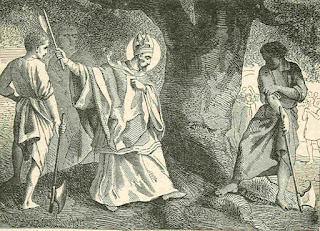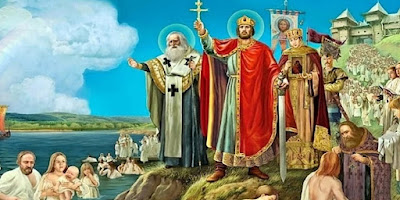Clotilde is considered a saint by both the Roman Catholic and Eastern Orthodox Churches. She was an early supporter of
St. Geneviève, she built the chapel that later became the
Abbey at Chelles, and it was probably her influence that persuaded her husband, Clovis, to return the
Vase of Soissons to St. Rémy after one of his soldiers took it post-conquest.
Most details of her life come from Gregory of Tours. She was born about 474 at Lyons, the daughter of King Chilperic II of Burgundy. Chilperic had two brothers, Gundobad and Godomar. At the death of their father, Gondioc, Gondioc's kingdom was divided among the three brothers. Gundobad turned on Godomar, and then on Chilperic, killing his brothers and their families, in order to reunite their father's kingdom under one ruler. Clotilde fled to her uncle, Godegisel.
Clovis and Godegisel joined in war against Gundobad, eventually defeating (but not killing) him; Clovis, King of the Franks, received an annual tribute from Burgundy after that. He also requested Clotilde's hand in marriage; Gundobad was not in a position to refuse.
Clovis I and Clotilde were married in 493. They had four sons (Ingomer, who died shortly after birth; Chlodomer, Childebert I, and ClotharI) and a daughter, Chrotilda. Clotilde insisted on baptism for her children; Clovis, not a Christian, objected, and when Ingomer died soon after birth and baptism, he criticized her. Yet, she persisted, and Chlodomer survived baptism, after which she had less opposition to raising the children in her faith.
Her greatest religious triumph may have been in 496 when Clovis was on the eve of battle with the Alemanni. He prayed to her God that he would be baptized if he were victorious. He prevailed in the Battle of Tolbiac and was baptized by Bishop Remigius of Reims on Christmas Day 496 (he is the St. Rémy in the link above). This Catholicism would aid him and his children in the future, ensuring the political support of the Roman Empire against many of the Franks' foes, who were Arian Christians.
When Clovis died in 523, Clotilde retired to the Abbey of St. Martin at Tours. She did not retire from public influence entirely, however. Even a saint is not immune to the desire for revenge, and the murderer of her father, her uncle Gundobad, was still ruling Burgundy. It is believed that her three sons' attack (and decade-long war) on Burgundy was instigated by her.
Also, her position as queen may have overruled the softer sensibilities one might expect from a mother and one who would later be considered a saint. During the war with Burgundy, her eldest son Chlodomer was killed. His part of the kingdom was to be divided among his three sons, further fracturing the kingdom of the Franks. Childebert and Clothar did not want this, and (the story goes), turned to Clotilde for... "advice." The two sent her two items: scissors and a sword. The implication was clear: the boys could be killed, or they could be shorn. (Long hair was a necessary mark of kingship for this particular culture, as mentioned here.) Supposedly, her reply was "It is better for me to see them dead rather than shorn, if they are not raised to the kingship." (Of course, we have no proof of this, but for these anecdotes to circulate about someone who was generally revered suggests there may be a kernel of truth.)
Clotilde died in 545 and was buried beside Clovis in the Church of the Holy Apostles (which is now the Abbey of St. Geneviève). Veneration of her made her the patron saint of queens, widows, brides, and those in exile.
Now, about that long hair think: how important was it? Let's talk about that tomorrow.




























